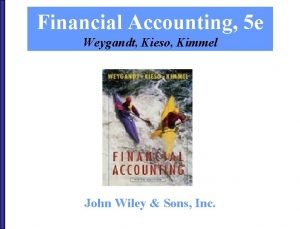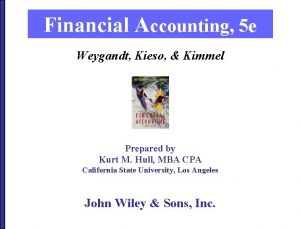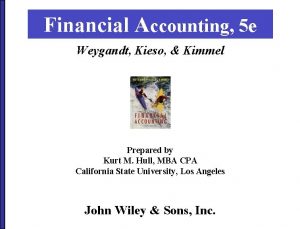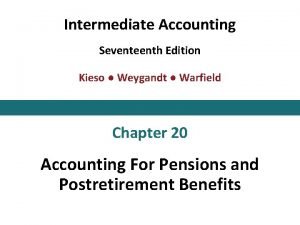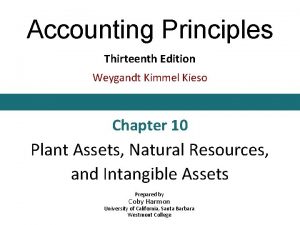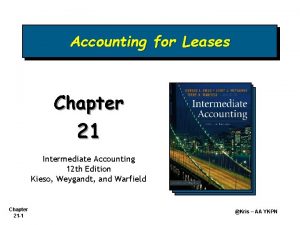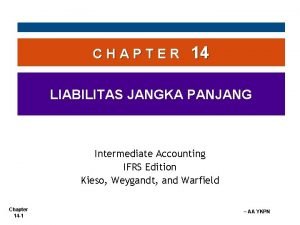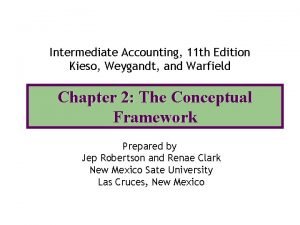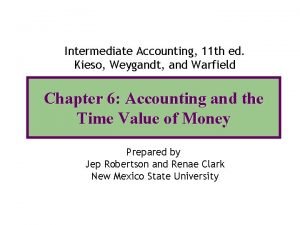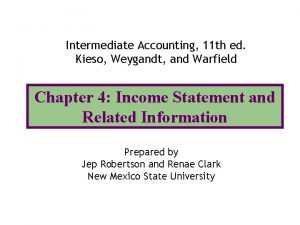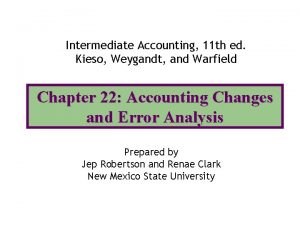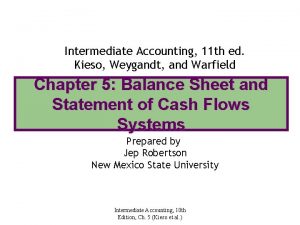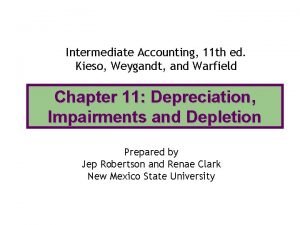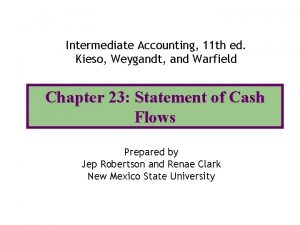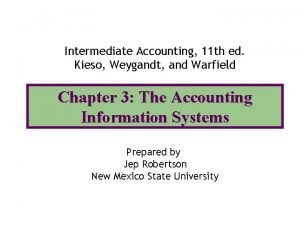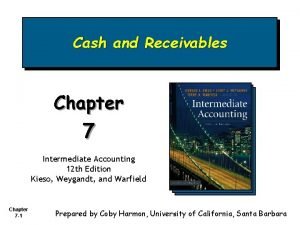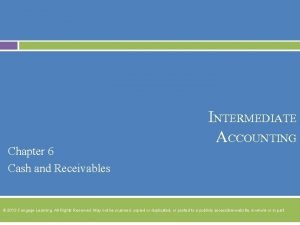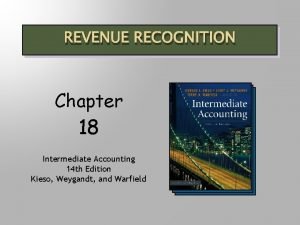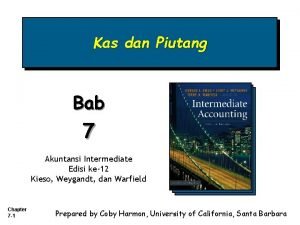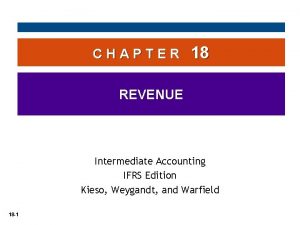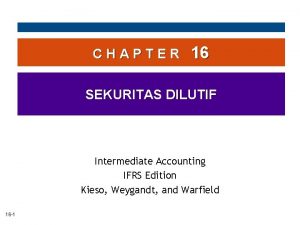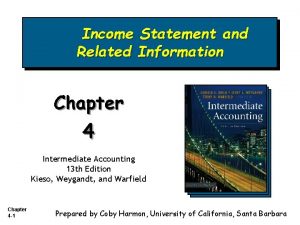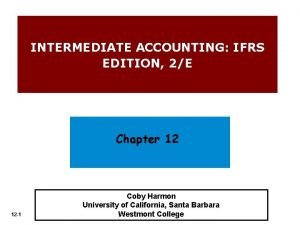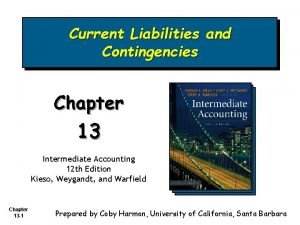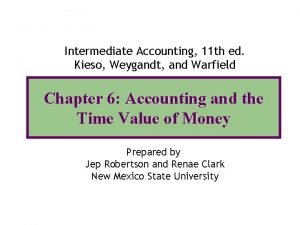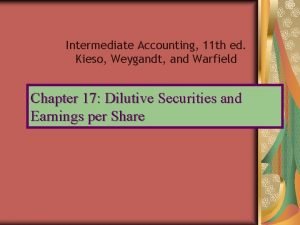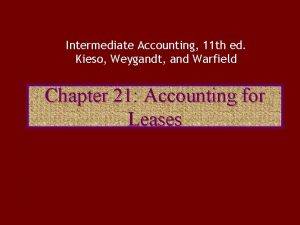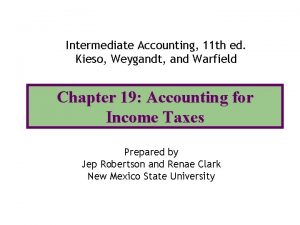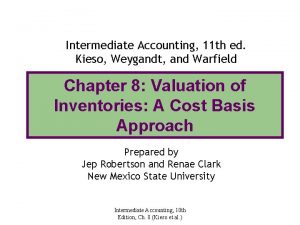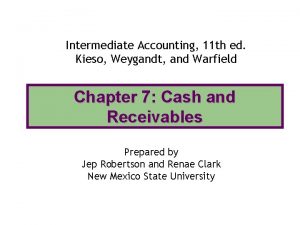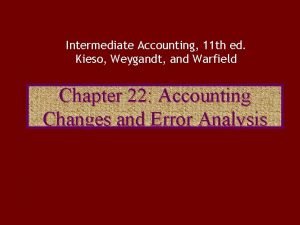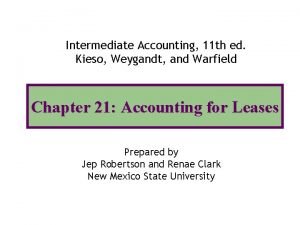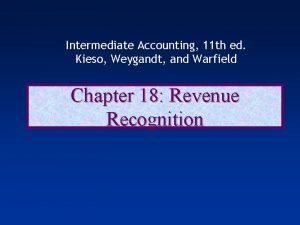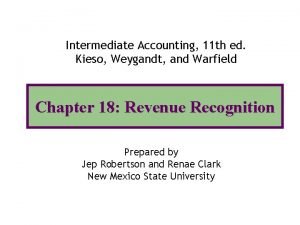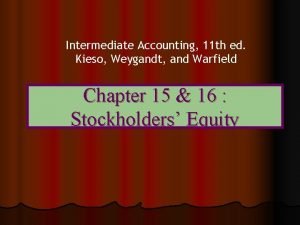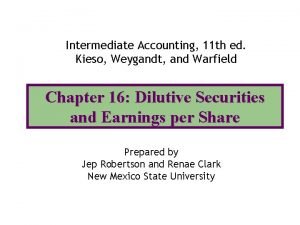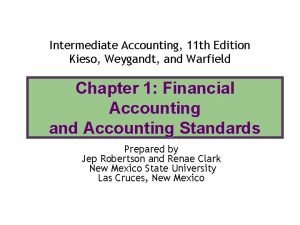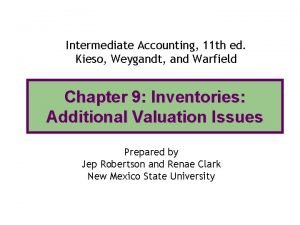Intermediate Accounting 11 th ed Kieso Weygandt and




























- Slides: 28

Intermediate Accounting, 11 th ed. Kieso, Weygandt, and Warfield Chapter 24: Full Disclosure in Financial Reporting Prepared by Jep Robertson and Renae Clark New Mexico State University

Chapter 24: Full Disclosure in Financial Reporting After studying this chapter, you should be able to: 1. Review the full disclosure principle and describe problems of implementation. 2. Explain the use of notes in financial statement preparation. 3. Describe the disclosure requirements for major segments of a business. 4. Describe the accounting problems associated with interim reporting.

Chapter 24: Full Disclosure in Financial Reporting 5. Identify the major disclosures found in the auditor’s report. 6. Understand management’s responsibilities for financials. 7. Identify issues related to financial forecasts and projections. 8. Describe the profession’s response to fraudulent financial reporting.

The Full Disclosure Principle The full disclosure principle calls for financial reporting of significant facts affecting the judgment of an informed reader. Two problems of implementing this principle are costs of disclosure and information overload. The profession is still in the process of developing guidelines as to: • whether a given transaction should be disclosed • what format this disclosure should take

Types of Financial Information

Increase in Reporting Requirements Reasons for increasing reporting requirements: • Complexity of the business environment (derivatives, business combinations, pensions) • Necessity for timely information (interim data, forecasts) • Accounting used as a control and monitoring device

Notes to the Financial Statements 1. Notes amplify or explain items presented in the body of the financial statements. 2. A statement that identifies the accounting policies of the entity must be disclosed (Summary of Significant Accounting Policies). 3. Some common notes are: • • • Inventory Deferred taxes PPE Contingencies and commitments Changes in accounting policies

Disclosure of Special Transactions or Special Issues Related party transactions (transactions not carried out at arm’s-length) Required disclosures: • • The nature of the relationship A description of the transactions The dollar amounts of transactions Amounts due from or due to related parties at the balance sheet date

Post-Balance Sheet Events Notes to the financial statements must explain any significant financial events that occurred after the balance sheet date, but before the issue of the financial statements. Financial statement period Post-balance sheet events Balance sheet date Issue date

Types of Transactions to be Disclosed Two types of post-balance sheet events must be disclosed: 1. Events that provide additional evidence about conditions that existed at the balance sheet date that require adjustments. 2. Events that arose subsequent to the balance sheet date, not requiring adjustments.

Reporting by Conglomerates • Investors need information regarding income statement, balance sheet, and cash flow statement. • Investors also need information about segments to assess profitability. • Segmented information may however harm reporting firms (disclosure of data useful to competitors).

Reporting by Conglomerates Objectives of reporting segmented information are to provide information about different types of business activities and the different economic environments in which the entities operate.

Identifying Operating Segments An operating segment is a component that: • engages in business activities, • is reviewed by the conglomerate’s chief operating officer; and • produces discrete financial information from the internal financial reporting system.

Aggregation of Operating Segments Operating segments may be aggregated if they have the same basic characteristics in: • • • products and services rendered production process type or class of customer methods of product or service distribution regulatory environment

Reportable Segments An operating segment is identified as a reportable segment if it satisfies one or more of the following criteria: 1. revenue criterion 2. profit or loss criterion 3. identifiable assets criterion

Reportable Segments Criterion Thresholds • Segment revenue • • Segment profit or loss • • Identifiable assets • Is more than ten percent of the combined revenue of all operating segments Is ten percent or more of the greater of: the combined profit of all operating segments not showing a loss, or the combined loss of all operating segments reporting a loss Ten percent or more of the combined assets of all operating segments

Required Segmented Information • General information about its operating segments • Segment profit and loss and related information • Segment assets • Reconciliation of segment revenues, profits and losses, and segment assets • Information about products and services and geographical areas • Major customers

Interim Reporting Requirements • Two approaches: integral and discrete • Most companies employ both approaches for • Reporting requirements: • Use of same accounting principles • Period costs often charged as incurred • Not required to publish Balance Sheet or SCF

Problems of Interim Reporting • Advertising and similar costs • Expenses subject to year-end adjustments • Income taxes • Extraordinary items • Changes in accounting principles • Earnings per share

Auditor’s Reports Auditor’s reporting standards: • states whether the financial statements are in conformity with GAAP • identify circumstances in which GAAP have not been consistently applied • disclosures in financial statements are deemed adequate unless otherwise stated • an opinion on the financial statements, if possible

Auditor’s Opinion The auditor can render or provide: • A qualified opinion • An unqualified opinion • Reasons requiring the addition of explanatory paragraphs to the unqualified report • An adverse opinion (circumstances) • A disclaimer

Management’s Report • Management’s Discussion and Analysis covers three aspects of an enterprise 1. Liquidity 2. Capital resources 3. Results of operations • Identifies favorable or unfavorable trends • Identifies any significant events and uncertainties that affect the three aspects

Financial Forecasts and Projections • The investing public needs and wants more and better information about corporate expectations. • The disclosures take one of two forms: 1. Financial forecast of an entity’s expected financial position 2. Financial projection based on hypothetical assumptions

Internet Financial Reporting • Corporations can reach more users by the internet • Internet reporting can make traditional reports more useful: • Corporations can report more timely information; • They can also report disaggregated data; • There is, however, concern about security on the internet (hackers).

Fraudulent Financial Reporting Defined as “intentional or reckless conduct, whether act or omission, that results in materially misleading financial statements. ” Could be gross and deliberate distortions Could be misapplication of accounting principles or failure to properly disclose material items

Fraudulent Financial Reporting: Causes • Impacted by internal and external environments • Opportunities increase in certain situations: 1. 2. 3. 4. Weak board of directors or audit committee Weak internal controls Unusual or complex transactions Accounting issues requiring significant subjective judgments 5. Ineffective internal audit function

Criteria for Making Accounting and Reporting Choices • Accounting is greatly influenced by its environment. • Alternative presentations of certain transactions will continue to exist. • The Conceptual Framework will hopefully eliminate unneeded diversity in reporting practices. • New oversight environment will impact accounting choices.

COPYRIGHT Copyright © 2004 John Wiley & Sons, Inc. All rights reserved. Reproduction or translation of this work beyond that permitted in Section 117 of the 1976 United States Copyright Act without the express written permission of the copyright owner is unlawful. Request for further information should be addressed to the Permissions Department, John Wiley & Sons, Inc. The purchaser may make back-up copies for his/her own use only and not for distribution or resale. The Publisher assumes no responsibility for errors, omissions, or damages, caused by the use of these programs or from the use of the information contained herein.
 Cost of goods manufactured formula
Cost of goods manufactured formula Kimmel accounting tools 5e
Kimmel accounting tools 5e Kimmel weygandt kieso accounting 5th edition
Kimmel weygandt kieso accounting 5th edition Kimmel weygandt kieso accounting 5th edition
Kimmel weygandt kieso accounting 5th edition Kieso weygandt warfield
Kieso weygandt warfield Weygandt kimmel kieso
Weygandt kimmel kieso Chapter 21 accounting for leases kieso terjemahan
Chapter 21 accounting for leases kieso terjemahan Chapter 14 intermediate accounting kieso bahasa indonesia
Chapter 14 intermediate accounting kieso bahasa indonesia Primary qualities of accounting information
Primary qualities of accounting information Intermediate accounting kieso
Intermediate accounting kieso Intermediate accounting kieso
Intermediate accounting kieso Intermediate accounting kieso
Intermediate accounting kieso Intermediate accounting
Intermediate accounting Impairment in finance meaning
Impairment in finance meaning Intermediate accounting kieso
Intermediate accounting kieso System of accounting
System of accounting Intermediate accounting chapter 17 investments pdf
Intermediate accounting chapter 17 investments pdf Notes receivable journal entry
Notes receivable journal entry Cash and receivables intermediate accounting
Cash and receivables intermediate accounting Intermediate accounting revenue recognition
Intermediate accounting revenue recognition Chapter 7 accounting
Chapter 7 accounting Kieso chapter 18 revenue recognition terjemahan
Kieso chapter 18 revenue recognition terjemahan Kieso chapter 16 bahasa indonesia
Kieso chapter 16 bahasa indonesia Intermediate accounting chapter 4
Intermediate accounting chapter 4 Intermediate accounting chapter 15
Intermediate accounting chapter 15 Patent impairment
Patent impairment Current liabilities and contingencies
Current liabilities and contingencies Residual value
Residual value Types of leases
Types of leases

